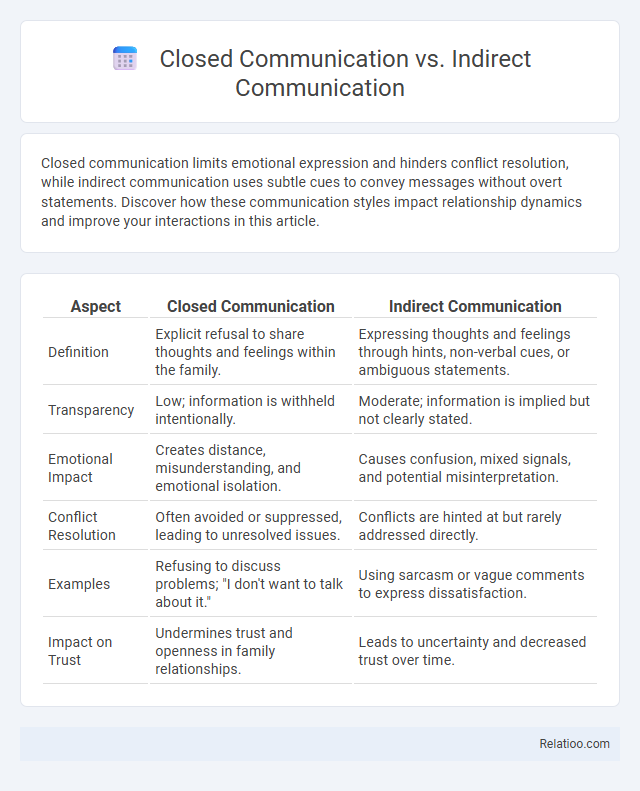Closed communication limits emotional expression and hinders conflict resolution, while indirect communication uses subtle cues to convey messages without overt statements. Discover how these communication styles impact relationship dynamics and improve your interactions in this article.
Table of Comparison
| Aspect | Closed Communication | Indirect Communication |
|---|---|---|
| Definition | Explicit refusal to share thoughts and feelings within the family. | Expressing thoughts and feelings through hints, non-verbal cues, or ambiguous statements. |
| Transparency | Low; information is withheld intentionally. | Moderate; information is implied but not clearly stated. |
| Emotional Impact | Creates distance, misunderstanding, and emotional isolation. | Causes confusion, mixed signals, and potential misinterpretation. |
| Conflict Resolution | Often avoided or suppressed, leading to unresolved issues. | Conflicts are hinted at but rarely addressed directly. |
| Examples | Refusing to discuss problems; "I don't want to talk about it." | Using sarcasm or vague comments to express dissatisfaction. |
| Impact on Trust | Undermines trust and openness in family relationships. | Leads to uncertainty and decreased trust over time. |
Understanding Closed Communication
Closed communication involves restricting information flow, where key details are withheld or messages are deliberately vague, hindering clear understanding. In contrast, indirect communication uses subtle hints, nonverbal cues, or implied meanings rather than straightforward expressions, often requiring you to interpret context carefully. Understanding closed communication helps you identify barriers to effective dialogue and promotes strategies for fostering openness and transparency in interactions.
Key Features of Closed Communication
Closed communication is characterized by limited information sharing, minimal feedback, and a lack of transparency, often leading to misunderstandings and reduced collaboration. Unlike indirect communication, which relies on subtle cues and implied messages, closed communication restricts openness by withholding details and discouraging dialogue. Your ability to recognize these key features helps improve clarity and fosters a more open and effective communication environment.
What Is Indirect Communication?
Indirect communication involves conveying messages in a subtle or roundabout manner, often relying on context, tone, or nonverbal cues rather than explicit statements. It contrasts with closed communication, where information is withheld or restricted, and open communication, which is transparent and straightforward. Indirect communication is common in cultures that value harmony and face-saving, requiring careful interpretation to understand the speaker's true intent.
Main Characteristics of Indirect Communication
Indirect communication relies on subtlety, context, and non-verbal cues to convey messages rather than explicit language, making it distinct from closed communication's more secretive nature. This style often employs ambiguity and implication, requiring the listener to interpret meaning beyond the spoken words. Understanding indirect communication helps you navigate social interactions where open confrontation is avoided.
Closed Communication vs Indirect Communication: Major Differences
Closed communication restricts the flow of information, limiting transparency and interaction to maintain control or confidentiality, whereas indirect communication relies on subtlety, hints, and non-verbal cues to convey messages without explicit statements. You may encounter closed communication in hierarchical or sensitive environments, while indirect communication often appears in cultures valuing politeness and harmony. Understanding these distinctions enhances your ability to navigate diverse communication styles effectively.
Cultural Influences on Communication Styles
Cultural influences significantly shape communication styles, where closed communication involves minimal information sharing and is prevalent in high-context cultures valuing privacy and hierarchy. Indirect communication, common in East Asian and Middle Eastern societies, relies on implication and nonverbal cues to convey messages subtly and maintain social harmony. Closed communication, often seen in collectivist cultures, emphasizes restraint and indirectness to prevent conflict and preserve relationships, contrasting with open, direct communication favored in individualistic cultures.
Advantages of Closed Communication
Closed Communication ensures clear, direct messaging that minimizes misunderstandings and promotes confidentiality, making it ideal for sensitive information exchange. Your team benefits from efficient decision-making and quicker problem resolution due to the streamlined flow of information. This communication style strengthens trust by limiting distractions and maintaining focus on key objectives.
Benefits of Indirect Communication
Indirect communication enhances your ability to convey messages subtly, fostering harmony and minimizing conflicts in sensitive situations. It allows the expression of thoughts and emotions through context, tone, and non-verbal cues, which can preserve relationships and encourage understanding without direct confrontation. Compared to closed communication, which limits information exchange, and overt communication, indirect communication provides nuanced interactions that can adapt to cultural and social dynamics effectively.
Challenges and Misunderstandings in Both Styles
Closed communication often leads to misunderstandings due to limited information exchange, causing confusion and mistrust in your interactions. Indirect communication can create challenges as subtle cues and implied messages may be misinterpreted, leading to unclear expectations and frustration. Both styles hinder effective collaboration by obscuring intentions and preventing open dialogue, ultimately impacting relationship dynamics and productivity.
Choosing the Right Communication Approach
Choosing the right communication approach depends on the context and desired outcomes; closed communication ensures privacy by limiting information flow, indirect communication relies on subtle cues and implicit messages, while open communication promotes transparency and trust. Your ability to analyze the situation and audience allows you to select a method that enhances clarity, reduces misunderstandings, and fosters effective collaboration. Understanding when to use confidentiality, nuance, or openness can significantly improve interpersonal and organizational communication dynamics.

Infographic: Closed Communication vs Indirect Communication
 relatioo.com
relatioo.com